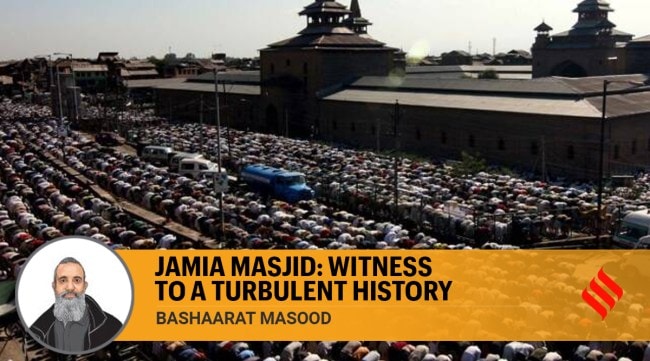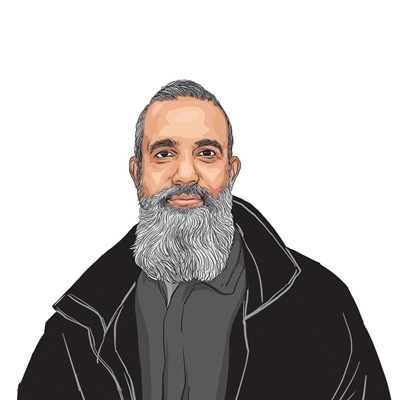Opinion Srinagar’s Grand Mosque: Witness to a turbulent history
Rebuilt several times after being ravaged by fires and the site of several key political events, the Jamia Masjid has for centuries stood witness to Kashmir’s chequered history
 The mosque has a capacity to house 33,000 worshippers at a time. Shuaib Masoodi
The mosque has a capacity to house 33,000 worshippers at a time. Shuaib Masoodi Another Eid went by in Kashmir on June 29, with congregational prayers being disallowed at Srinagar’s historic Jamia Masjid, along with the Eidgah. Since 2008, the Jamia Masjid or the ‘Grand Mosque’, the centre of religion and politics in Kashmir, has often been shut down for worshippers by successive governments to “prevent anti-government protests” in the Valley.
Situated at Nowhatta in Srinagar’s old city — a separatist stronghold once
known as the Gaza of Kashmir Valley for the stone-throwing protests that erupted here — the Grand Mosque has for centuries stood witness to Kashmir’s chequered history.
Built in the first decade of the 15th century during the reign of the Shah Miri dynasty, and rebuilt several times after being ravaged by fires, the present structure was built during the Mughal rule as a combination of Persian and Buddhist Pagoda architecture. With a capacity to house 33,000 worshippers at a time, the 384×381 feet quadrangular structure stands on 386 wooden columns, some 48 feet tall and with a girth of six feet.

“Srinagar Jamia Masjid is a symbol of Kashmir’s identity and has a deep-rooted relationship to Islam. For centuries, as a centre of learning and understanding Islam, the relationship between the people and their faith has been actively nurtured at the mosque,” Hurriyat Conference leader Mirwaiz Umar Farooq, who has been under house detention since August 4, 2019, told The Indian Express. As head priest of the Valley, members of the Mirwaiz’s family have traditionally delivered the Friday sermons from the pulpit of the Grand Mosque.

The first time the mosque was closed for worshippers was during the rule of Maharaja Ranjit Singh in the early 19th century. As the mosque stayed shut for over two decades, it is said that it was turned into a stable. For another 11 years since then, the mosque was opened only for Friday prayers.
Besides imparting religious education to the people of the Valley, the Grand Mosque has been at the centre of some of the biggest political happenings in the Valley.
It was this mosque from where Sheikh Abdullah was initiated into Kashmir politics and catapulted as a mass leader of the Muslim Conference, Kashmir’s first major political party.
On July 13, 1931, when 22 Kashmiri Muslims were killed fighting the Dogra police outside Srinagar’s central jail — the incident, marked as martyrs’ day in the Valley, is considered the first major political awakening among Kashmiri Muslims — their bodies were taken to the Jamia Masjid. Abdullah has, during his political career, often narrated an incident that he said took place at the mosque where the dead and the dying were brought. Abdullah said that here, a man drawing his last breath told him that he should not forget their sacrifices — something he heavily drew on to affirm his leadership.

When Abdullah split the Muslim Conference in 1939 and founded the National Conference, which, with its secular character and openly pro-India stance was a clean break from its parent parent, it pitted him against the Mirwaiz family.
For many decades, the Grand Mosque has been the centre of religion and politics for the Mirwaiz family that was traditionally seen as being pro-Pakistan. So when militancy erupted in Kashmir at the end of 1980s, the Grand Mosque also became the centre of Kashmir’s separatist politics. On August 25, 1989, with the start of militancy in the Valley, paramilitary forces raided the mosque to make arrests, raising allegations of desecration and leading to massive protests in the Valley. Mirwaiz Mohammad Farooq, father of Mirwaiz Umar Farooq, was then the head priest.
After the assassination of Mirwaiz Farooq on May 21, 1990 by unidentified militants, Mirwaiz Umar Farooq — barely 17 years old then — was anointed the head priest. A few years later, Umar became the first chairman of the separatist conglomerate, the Hurriyat Conference, and the Grand Mosque became his religious and political platform.
It was from this mosque that the separatists would rally support for Kashmir’s “freedom” struggle, with the Friday prayers often followed by pro-azadi protests and stone-throwing clashes with the police.

It was during one such gatherings, in 2017, as thousands gathered for Ramzan prayers, that a mob lynched Deputy Superintendent of Police (DSP) Ayub Pandit when he was on duty outside the mosque. The mob, suspecting Pandit to be an intelligence officer, lynched him and threw his body on the roadside. His identity could be ascertained only the following morning.
A year later, in 2018, a few unidentified persons took over the pulpit of the Grand Mosque, raised slogans in support of the Islamic State and unfurled the flag of the outfit. The incident was condemned both by the government and Mirwaiz Umar Farooq.
Since 2008, when Kashmir erupted in anger against the Amarnath land row, the mosque has been shut for worshippers several times by successive political governments — from the National Conference to the People’s Democratic Party (PDP). However, one of the biggest shutdowns came after August 5, 2019, when the Centre abrogated J&K’s special status and turned the state into two Union Territories. Mirwaiz Umar Farooq was put under house detention and the Grand Mosque was shut for worshippers for 136 days. While over four months later regular prayers were allowed at the mosque, Friday prayers and big congregations were disallowed with police fearing law and order situations.
While the Anjuman Auqaf, set up in 1975 to manage the affairs of the mosque, has termed the ban on prayers at the mosque “interference in religion” and an attempt to weaken the “centrality of this spiritual and religious centre of Muslims”, political experts say the mosque and the shutdowns have, as always, been a bellwether for the political situation in the Valley.






